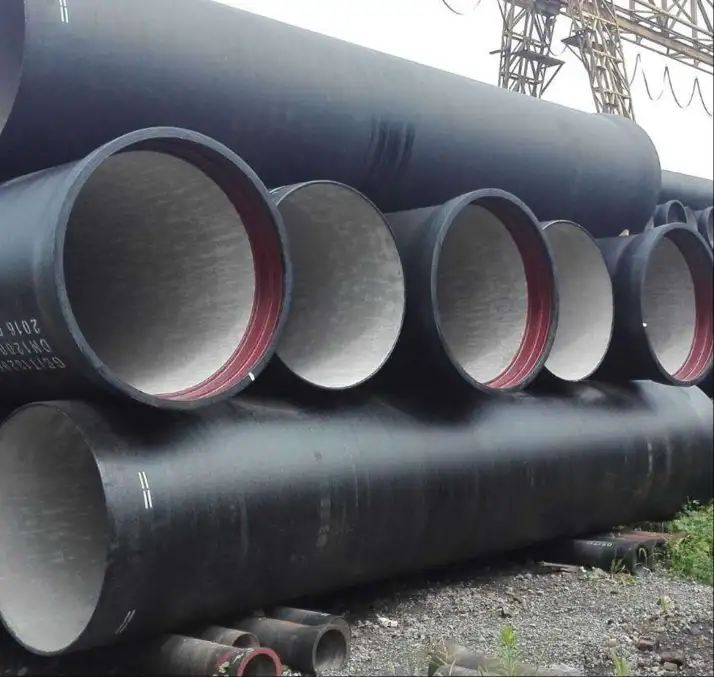Ductile iron pipes have become a cornerstone in modern infrastructure, particularly in water and wastewater systems. Their strength, durability, and resistance to corrosion make them ideal for transporting potable water, sewage, and other fluids under pressure. Understanding the classification of ductile iron pipes is crucial for engineers, contractors, and municipalities to ensure the selection of the right pipe for specific applications.

What is Ductile Iron Pipe?
Ductile iron pipe is a type of cast iron pipe that incorporates spheroidal graphite (nodular cast iron) to enhance its strength and ductility. This modification allows the pipe to withstand higher pressures and resist cracking, making it suitable for a wide range of applications.
1. Classification of Ductile Iron Pipes
Ductile iron pipes are primarily classified based on two systems: Pressure Class and Thickness Class. These classifications determine the pipe’s ability to withstand internal pressure and external loads.
Pressure Class (C-Class)
The Pressure Class classification is defined by the American Water Works Association (AWWA) standard C150/A21.50. It specifies the maximum internal pressure that a pipe can safely withstand without failure. The Pressure Class is expressed in pounds per square inch (psi) and is determined by the pipe’s wall thickness and material strength.
Thickness Class (K-Class)
The Thickness Class classification, defined by AWWA standard C151/A21.51, categorizes pipes based on their wall thickness. The K-Class system includes classes K5 through K12, with K5 having the thinnest walls and K12 the thickest. This classification is particularly useful for determining the pipe’s ability to resist external loads and soil pressure.
2. Comparison of Pressure Class and Thickness Class
| Feature | Pressure Class (C-Class) | Thickness Class (K-Class) |
|---|---|---|
| Definition | Based on internal pressure | Based on wall thickness |
| Standard | AWWA C150/A21.50 | AWWA C151/A21.51 |
| Units | Pounds per square inch (psi) | Class number (K5 to K12) |
| Primary Use | Determining internal pressure capacity | Determining external load resistance |
| Selection Criteria | Pipe diameter and material strength | Soil conditions and external loads |
3. Manufacturing Standards and Specifications
Ductile iron pipes are manufactured following stringent standards to ensure quality and performance. Key standards include:
-
AWWA C151/A21.51: Standard for Ductile-Iron Pipe, Centrifugally Cast, for Water
-
AWWA C150/A21.50: Standard for Thickness Design of Ductile-Iron Pipe
-
AWWA C104/A21.4: Standard for Cement-Mortar Lining for Ductile-Iron Pipe and Fittings for Water
-
AWWA C110/A21.10: Standard for Ductile-Iron and Gray-Iron Fittings for Water
These standards ensure that ductile iron pipes meet the necessary requirements for strength, durability, and corrosion resistance.
4. Applications of Ductile Iron Pipes
Ductile iron pipes are used in various applications, including:
-
Potable Water Systems: Transporting drinking water in municipal and industrial settings.
-
Sewer Systems: Conveying wastewater in urban and rural areas.
-
Irrigation Systems: Delivering water for agricultural purposes.
-
Fire Protection Systems: Supplying water for firefighting efforts.
The versatility of ductile iron pipes makes them suitable for both underground and above-ground installations.
5. Selecting the Right Ductile Iron Pipe
When selecting a ductile iron pipe, consider the following factors:
-
Internal Pressure Requirements: Determine the maximum internal pressure the pipe will experience to select the appropriate Pressure Class.
-
External Load Conditions: Assess soil conditions and external loads to choose the suitable Thickness Class.
-
Pipe Diameter: Larger diameters may require higher Pressure or Thickness Classes.
-
Corrosion Resistance: Evaluate the need for protective coatings or linings based on environmental conditions.
6. Common Questions About Ductile Iron Pipe Classification
Q1: What is the difference between Pressure Class and Thickness Class?
The primary distinction lies in what each classification measures. Pressure Class (C-Class) focuses on the pipe’s ability to withstand internal pressure, while Thickness Class (K-Class) pertains to the pipe’s wall thickness, which influences its capacity to resist external loads and soil pressure.
Q2: How do I determine the appropriate class for my project?
Consider factors such as the maximum internal pressure, soil conditions, external loads, and pipe diameter. Consulting with a professional engineer and referring to the AWWA standards can guide you in selecting the correct class.
Q3: Can ductile iron pipes be used for both potable water and wastewater?
Yes, ductile iron pipes are versatile and can be used for both potable water and wastewater systems. However, different linings and coatings may be required to prevent corrosion and ensure safety, especially for potable water applications.
Q4: What are the benefits of using ductile iron pipes over other materials?
Ductile iron pipes offer several advantages, including:
-
High strength and durability
-
Resistance to corrosion
-
Ability to withstand high internal pressures
-
Long service life
-
Recyclability
Q5: Are there international standards for ductile iron pipes?
Yes, international standards such as ISO 2531 and EN 545 provide guidelines for the design, manufacturing, and testing of ductile iron pipes, ensuring consistency and quality across different regions.
Conclusion
Understanding the classification of ductile iron pipes is essential for selecting the right pipe for your specific application. By considering factors like internal pressure, external loads, and soil conditions, and adhering to established standards, you can ensure the longevity and reliability of your piping system.

